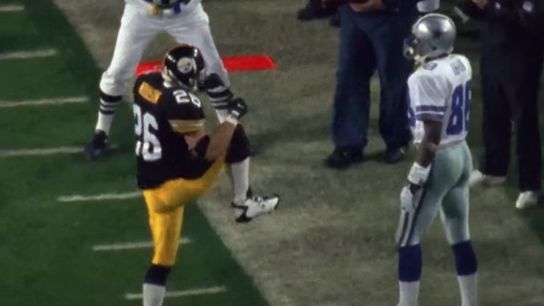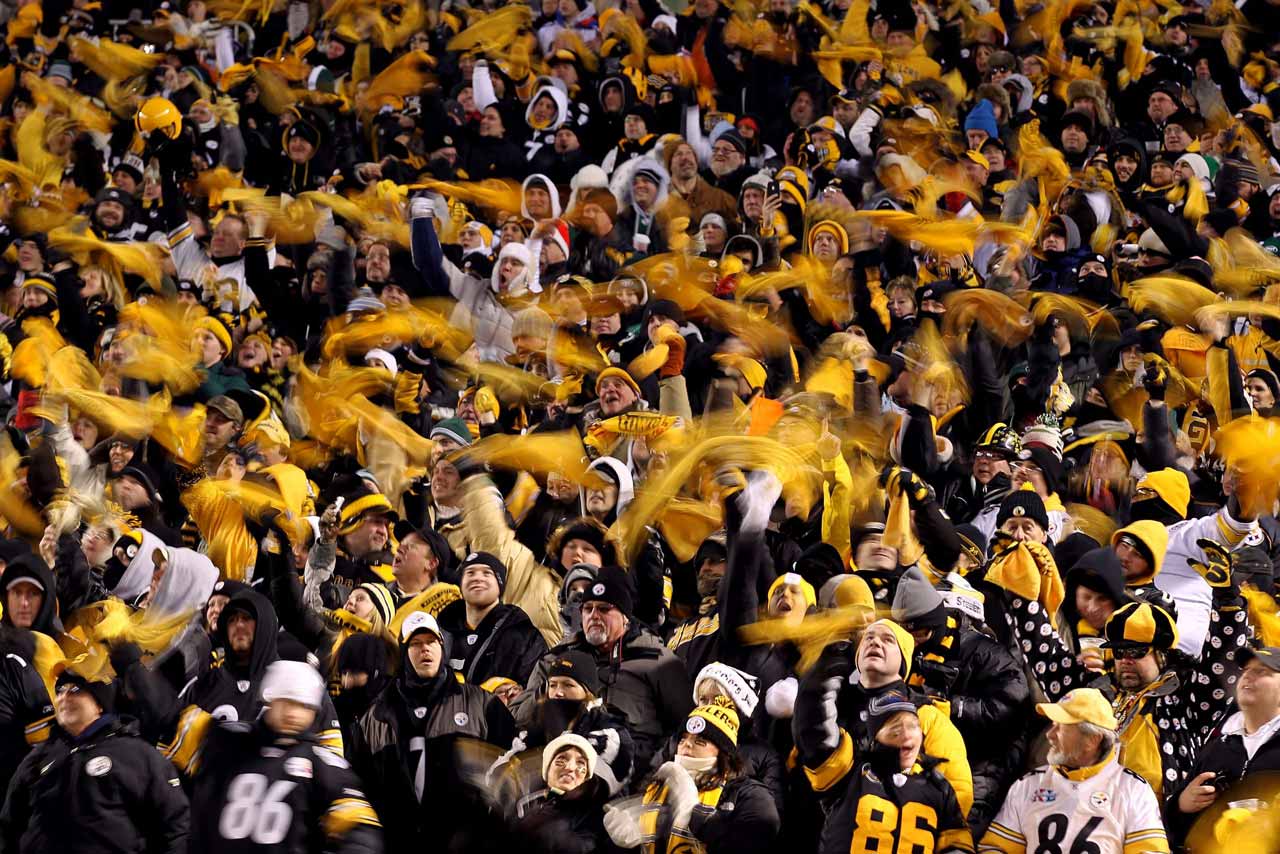The Pittsburgh Steelers' legacy of greatness is unrivaled by any team in NFL history. The Hall of Fame is full of Steelers legends as a wing literally needs to be built to house them all. The debate surrounding the All-Time Steelers greats is endless, but there is one in particular that is unique in that it encompasses the two best defensive players post Steel Curtain: Rod Woodson and Troy Polamalu.

Steelers' Rod Woodson was the cornerstone of the Blitzburgh Defense | Photo Credit: NFL Films
Part I - Rod Woodson
When the Steelers saw how impressive Rod Woodson was at the combine, they stopped evaluating him. Chuck Noll lamented his workout “probably took him away from us” and instructed his defensive coordinator Tony Dungy not to waste his time going to Woodson’s pro day as he would never last until the tenth pick.
However, on draft day, Woodson began to slide. A player that most had rated as the number four player in the draft carried some concerns that resulted in teams passing on him. One was the very real possibility that his competing in the 1988 Olympics would delay his joining a team until mid-1988. The other was a rumor of his getting into some trouble just before the draft.
Tom Donahoe per On The Clock: The Pittsburgh Steelers
“I was a college scout when he was coming out. We didn’t think we had any shot to get him because of the career that he put together. But he got into trouble right before the draft," Donahoe said. "I can’t remember exactly what it was, so we probably should’ve vetted him more than we did, but we didn’t think we could get him, and the draft started, and he started sliding. So, when we saw that his name was going to get to us, it was a no-brainer. We had got enough work on him that we were comfortable picking him, and he had an unbelievable career.”
Personnel director Dick Haley announced that Woodson, who played safety at Purdue, would be a cornerback. Woodson himself confirmed how surprised the Steelers were to get him as he “could hear it in their voices.” Pro Football Weekly reported that the Steelers' luck had changed. They couldn’t have possibly known how correct they were.
Whether or not Woodson really had "trouble" before the draft is uncertain. However, the possibility of not having him due to the Olympics was very real. In late August of 1987, Woodson informed the Steelers through his agent that he would sign if he could join the team in 1988 and the Steelers declined. A 95-day holdout ensued that was only solved through an intervention by Tony Dungy. Dungy went to meet Woodson at a track meet in North Carolina to pitch him on joining the Steelers.
Tony Dungy per On The Clock: The Pittsburgh Steelers
“You can run track and probably be world-class, or you can play corner and be one of the best that ever played," Dungy said.
Woodson bought Dungy's pitch and joined the Steelers for the final eight games of the 1987 season, playing as nickel and return specialist. By 1988, he was the full-time starter and tied Dwayne Woodruff for the team lead in interceptions. By 1989, he was the best defensive back in the NFL.
Like Joe Greene before him, Woodson turned out to be the cornerstone on which the Steelers were built heading into the great Blitzburgh teams of the 1990s. While Woodson was not blessed playing with a Terry Bradshaw or Ben Roethlisberger at franchise quarterback to help the 1990s Steelers attain the Super Bowl legacy, he redefined the position as one of the greatest players of all time.
By 1989, Woodson was the premier cornerback in the NFL and began his All-Pro honors. In 1993, he became the first Steelers defensive player since the Steel Curtain to earn Defensive Player of the Year honors. He showed just how much he deserved the award when the Steelers' playoff chances hung in the balance with a game versus the Cleveland Browns, and Woodson suffering from a knee injury. Bill Cowher was forced to ask his most important player to fill a role and it turned out to be more than he expected.

Steelers Rod Woodson overcame an injury to seal a critical win vs. Cleveland Browns in 1993 | Photo Credit: NFL Films
Bill Cowher per Heart and Steel:
“I never asked players to play hurt. I didn’t want them to do anything that would aggravate their injuries or, even worse, put their careers in jeopardy. It was also true that everyone in the NFL plays in pain. I told Rod that if the Browns knew beforehand he wasn’t going to play, Bill Belichick and his staff would devise schemes to take advantage of his absence.”
“I asked him to consider a safe plan. If you can go out there for one or two plays, then we’ll get you out of there for the rest of the game. Then they’ll have to make their adjustments on the sideline.”
“Woodson nodded. It never crossed my mind that his nod meant that he was planning to play the entire game. He did just that, and he did it at about 50% of his capability. He played within himself and didn’t take any chances, yet he still managed to be Rod Woodson," Cowher finished.
However, it was in 1994 when the 1990s Steelers defense designed by Dick LeBeau and led by Woodson and Greg Lloyd stepped out of the shadow of the Steel Curtain as Blitzburgh to forge their own identity. The signature game that started it was a Monday Night Football game versus the Buffalo Bills. When the game began, Jim Kelly and the Bills were the top team in the AFC. But as it ended, with arguably the greatest single-game performance of his career, Rod Woodson put an end to the Bills' run on his own.
Bill Cowher per Heart and Steel:
“Rod told me the previous Sunday he’d heard on TV Buffalo quarterback Jim Kelly call an audible. The play was a three-step hitch, which meant that the receiver took three steps, turned, and the ball was right there for him. Rod said that if he heard Kelly call it during our game, he was going to jump it. I knew he could, too. He was so athletic that if he knew what was coming, he could get to the ball a step and a half before Kelly’s intended receiver could.”
“Sure enough, Kelly called that audible early in the game. Rod told Darren (Perry), ‘I’m jumping it.’”
“When Kelly threw that 3-yard hitch, Rod was right there to step in front of it, catch it, and run 37 yards for a touchdown," Cowher said.
Woodson outscored the Buffalo offense by himself with a pick-six and forced fumble (Gerald Williams landed on it in the endzone) to generate touchdowns in the Steelers' 23-10 win. The Steelers' defense was the league’s best and most dynamic and Woodson was the centerpiece. However the 1994 season was destined for disappointment when the Steelers lost to the San Diego Chargers in the most disappointing game in Steelers history, sentiments echoed by Woodson himself.
Rod Woodson per On The Clock: The Pittsburgh Steelers
“The most disappointing play in my years playing there was when Tim McKyer got beat on third-and-14,” Woodson said.
"I think we had the best team and should’ve been in the Super Bowl three years in a row.”
In 1995, Woodson tore his ACL in the first game of the season and threatened the Steelers' Super Bowl chances. His regular season was over, but despite the normal recovery time for an ACL being a year, Woodson’s season wasn’t. He never went on injured reserve in the hopes that he would be there in case of reaching the Super Bowl.
It meant the Steelers would be one player short the entire season, and for anyone else they would not have done it. But Rod Woodson was not just “anyone else” and when the Steelers reached Super Bowl XXX versus the Dallas Cowboys, Cowher was glad to have him back.

Steelers' Rod Woodson breaks up a pass to Michael Irvin in Super Bowl XXX | Photo Credit: NFL Films
Bill Cowher per Heart and Steel:
"I knew we needed our best game of the year to beat Dallas, and I was encouraged, and in awe, that Rod Woodson was declared active for the game. As soon as he stepped on the field, Rod would become the first player in league history to return to play in the same season in which he’d had reconstructive knee surgery. His mental and physical toughness, and his leadership, inspired our entire organization," Cowher said.
While the Steelers lost Super Bowl XXX in heartbreaking fashion, one could only wonder if a 100% Rod Woodson could have made a difference in terms of generating a game-changing play. Heading into the game the Cowboys wide receiver Michael Irvin stuck his foot in his overbearing mouth when he fed into Woodson's motivation, questioning him by asking "How can a guy who just had surgery on his knee run on the autobahn?"
Irvin found out that Rod Woodson was more than up for the challenge and ended up serving him a dish of humble pie, breaking up a pass, pointing to that knee, and making certain Irvin knew he was more than able to keep up. Irvin eventually found out the hard way after an ACL tear that he wasn't half the competitor Woodson was. Unfortunately, Woodson was limited to only 12 plays in Super Bowl XXX.

Steelers' Rod Woodson sets to cover Michael Irvin in Super Bowl XXX | Photo Credit: NFL Films
Michael Irvin per NFL Films:
“I was blown away. There was no way he was supposed to be able to make that play. He pointed at his knee, and I said oh. What a dude. What a man. Because I’m telling you that injury darn near broke me," Irvin said.
Woodson would later wonder if his rushed return for the game was the beginning of his end in Pittsburgh. He played the following season with an injury that he felt was due to overcompensation, and wasn't up to his standard. The perception became a misjudged reality with a low contract offer in 1997 that led to his departure. The problem is that Woodson set a standard so high that a "down year" in 1996 was arguably still better than any single-season performance by a Steelers cornerback since.
In the playoffs versus the Indianapolis Colts, who took the Steelers to the final seconds of the AFC Championship without Woodson, were obliterated 42-14. One of the most impressive plays of the game came when Woodson, blocked by Marvin Harrison, literally ran through the Colts WR into Marshall Faulk to make the tackle.

Steelers Rod Woodson shoves Marvin Harrison into Marshall Faulk to make an unbelievable tackle. | Photo Credit: NFL Films
Bill Cowher has called Woodson the greatest player he ever coached and the decision to not resign him was a mistake he both acknowledged and regretted. It’s a legitimate question as to whether or not Rod Woodson could have gotten the Steelers over the top as they had Super Bowl-caliber teams in 1997 and 2001, with it more likely that he would have than not. Woodson was the final piece the Baltimore Ravens needed to cap off their 2000 Super Bowl, leaving Steeler Nation to always wonder.
#Steeler Nation



